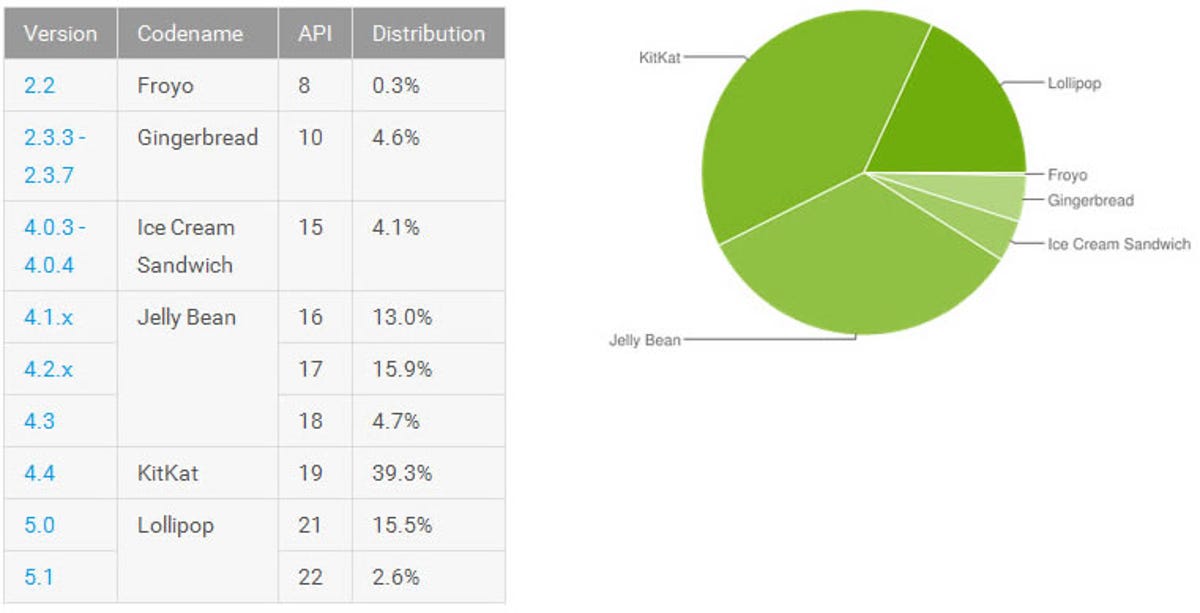
Apple/screenshot by Lance Whitney/CNET
iOS 8 continues to rise up the ranks, albeit a bit more slowly these days.
Apple’s latest mobile OS is now on 85 percent of all iOS devices, according to Apple’s App Store Distribution page. That figure refers specifically to all iPhones, iPads and iPod Touches that visited Apple’s App Store on Monday, August 3. iOS’s adoption rate has actually been slowing down. In late April, iOS 8 was on 81 percent of all iOS devices, so in three months, the rate has risen only by 4 percentage points.
But 85 percent is still an impressive number, especially since iOS 8 got off to a slow start as it was plagued by a number of initial bugs. And iOS 9 is due for lift-off next month, so some iOS 7 users may be holding off on iOS 8, waiting to upgrade to the new version.
And what about iOS rival Android? The latest flavor, namely Android Lollipop, is on just 18 percent of all devices running Google’s mobile OS, according to the latest Android Developers Dashboard. Drilling down, Android 5.0 is nestled on 15.5 percent of all devices that visited the Google Play store during the seven-day period ending August 3, while Android 5.1 is only 2.6 percent of devices.
Released last September, iOS 8 did have a head start over Android 5.0, which launched last November. But that’s not a big head start. So why is iOS 8 on such a greater percentage of devices? The answer lies in the Android distribution process. Apple controls the entire process of rolling out a new version of iOS as well as incremental updates. Apple creates, tests, and then deploys a new OS so it’s easily available for all iOS users at the same time.
On the flip side, new versions of Android face a more difficult time getting into the hands of users. In a “too many cooks in the kitchen” scenario, Google must first create and test a new version of Android. Then the mobile device makers get involved by doing their own testing and certification. And unlike iOS, which includes just three devices — the iPhone, iPad and iPod Touch — the world of Android is flooded with hundreds and hundreds of different devices from various manufacturers. Every manufacturer must test a new version or update on each of its devices. Finally, the mobile carriers step in to test and deploy a new version of Android. So a system that’s relatively quick and painless for iOS is relatively long and painful for Android.
The process also leads to Android fragmentation. Just as a mobile device maker or carrier is deploying an existing version of Android, a new version is usually already available. So the manufacturers and carriers are constantly playing a game of catch-up. This means that several different versions of Android are installed on users’ devices at any given time.
The latest Android Developers Dashboard paints a typical picture. Though Lollipop is catching up in adoption, the prior edition, KitKat, holds the lead at 39.3 percent. The version before KitKat, Jelly Bean, is still up there with a 33.6 percent share. Even older versions, such as Ice Cream Sandwich and Gingerbread remain in the game with shares of 4.1 percent and 4.6 percent, respectively.


Google/screenshot by Lance Whitney/CNET
This type of fragmentation frustrates Android users, who are always clamoring for the latest version. But it also frustrates Android app developers, who decide which versions to support.
In contrast, Apple’s iOS 7 is down to a share of 13 percent, while older versions of iOS are scraping out a mere 2 percent. There is no problem with iOS fragmentation since users can freely download the latest version of iOS as soon as it’s available and assuming their device supports it. And developers can design their apps for the current version of iOS and then gradually take advantage of any new features offered in the newest version.
Fragmentation certainly doesn’t affect the popularity of Android, which towers over iOS in market share and sales throughout the world. But the problem does make Android updates much more messy than those for iOS. So the whole update process is one that Google needs to find a way to streamline for the benefit of both Android users and developers.



